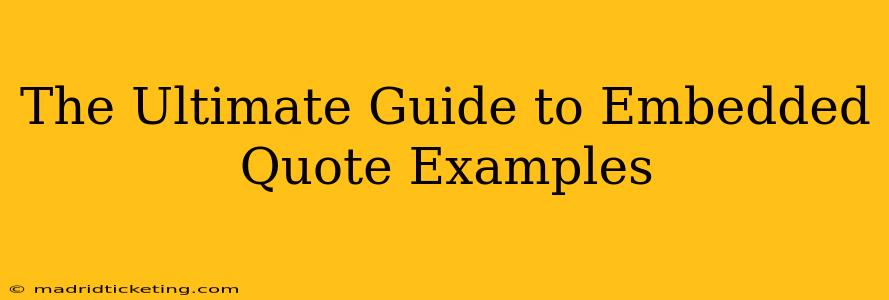Mastering the art of embedding quotes seamlessly into your writing elevates your prose, adds credibility, and strengthens your arguments. Whether you're crafting a blog post, academic paper, or even a compelling email, knowing how to effectively use embedded quotes is crucial. This comprehensive guide will delve into various examples, explore best practices, and answer your frequently asked questions regarding embedded quotes.
What are Embedded Quotes?
Embedded quotes, also known as integrated quotes or run-in quotes, are short quotations incorporated directly into the flow of your sentence. Unlike block quotes, which are set apart visually, embedded quotes are smoothly integrated, making them less disruptive to the reading experience. They're typically used for quotes under four lines and are often introduced by a signal phrase.
Why Use Embedded Quotes?
Embedded quotes offer several advantages:
- Improved Flow: They maintain a natural reading rhythm, preventing abrupt shifts in tone or style.
- Conciseness: They are ideal for short, impactful quotations that support your point without interrupting the narrative.
- Emphasis: Integrating quotes directly into your sentences allows you to highlight key phrases or ideas.
- Smooth Integration: They blend seamlessly with your writing style, making the quote a natural part of your argument.
Examples of Embedded Quotes
Let's examine various examples to showcase the versatility of embedded quotes:
Example 1: Introducing the Quote with a Verb:
"The quick brown fox jumps over the lazy dog," as the famous proverb states, perfectly illustrates the concept of alliteration.
Example 2: Using a Comma:
Einstein famously declared, "Imagination is more important than knowledge."
Example 3: Integrating the Quote with a Colon:
The author's central argument can be summarized as follows: "The true measure of a man is not how he gets knocked down, but how he gets up."
Example 4: Using a Semicolon:
The study concluded that stress significantly impacts health; researchers noted, "Chronic stress can weaken the immune system and increase the risk of various diseases."
Example 5: Integrating a Quote within a Longer Sentence:
While discussing the importance of perseverance, the motivational speaker emphasized that "giving up is never an option, even when faced with overwhelming obstacles."
How to Punctuate Embedded Quotes Correctly
Correct punctuation is vital for clarity and accuracy. Here are the essential guidelines:
- Commas and Periods: Always place commas and periods inside the closing quotation marks.
- Colons and Semicolons: Place these punctuation marks outside the closing quotation marks.
- Question Marks and Exclamation Points: Place these punctuation marks inside the closing quotation marks if they are part of the original quote. Place them outside if the entire sentence, including the quote, is a question or exclamation.
What are the differences between embedded quotes and block quotes?
This is a common question. The key difference lies in length and visual presentation. Embedded quotes are short and integrated into the sentence structure. Block quotes, on the other hand, are longer (generally four lines or more) and are set apart from the main text with indentation and sometimes a different font size. Block quotes are used to give more prominence to a longer, more impactful passage.
How do I cite embedded quotes?
Proper citation is crucial to avoid plagiarism. The method depends on the citation style you're using (MLA, APA, Chicago, etc.). Typically, you'll include the author's name and the publication information in a footnote or endnote, or use in-text citations, depending on the style guide.
Can I change words in an embedded quote?
Generally, you should not alter the wording of an embedded quote unless absolutely necessary. If you must make a minor change, such as correcting a spelling error, enclose the change in square brackets [ ]. Significant alterations are unacceptable and constitute plagiarism.
How long should an embedded quote be?
Embedded quotes are typically short—four lines or less. If the quote is longer, consider using a block quote instead for better readability.
By following these guidelines and exploring the diverse examples provided, you can confidently and effectively incorporate embedded quotes into your writing, enhancing its clarity, impact, and overall quality. Remember that proper citation and accurate punctuation are paramount.

